Abstract
In Sauton's synthetic liquid medium, 10 μg of pyridoxal per ml completely protected Mycobacterium tuberculosis (H37Ra) from the effects of a minimal inhibitory concentration of isoniazid (0.01 μg/ml). 14C-labeled isoniazid was employed to study the nature of this protective effect. Uptake of the drug by cells in a Sauton environment containing 0.01 μg of 14C-isoniazid per ml was inhibited 20 to 40% by 10 μg of pyridoxal per ml during the early hours of drug exposure. A stronger inhibition of uptake resulted when labeled isoniazid and pyridoxal were increased to 0.1 μg/ml and 50 to 100 μg/ml, respectively. Further studies revealed that certain Sauton nutrients are required to achieve this effect. When l-asparagine or salts (MgSO4 and ferric ammonium citrate) or both were deleted from the menstruum, pyridoxal did not inhibit isoniazid incorporation by the tubercle bacilli. Pyridoxal also failed to inhibit uptake when (NH4)2SO4 was substituted for l-asparagine. Growth experiments in Sauton's medium modified to contain (NH4)2SO4 instead of l-asparagine were consistent with the latter finding. Pyridoxal did not prevent isoniazid growth inhibition in this medium. It is postulated that a large excess of pyridoxal in Sauton's medium protects tubercle bacilli from the effects of isoniazid through formation of an extracellular complex involving drug, vitamin, and certain medium constituents, thereby reducing the level of isoniazid available to the cells.
Full text
PDF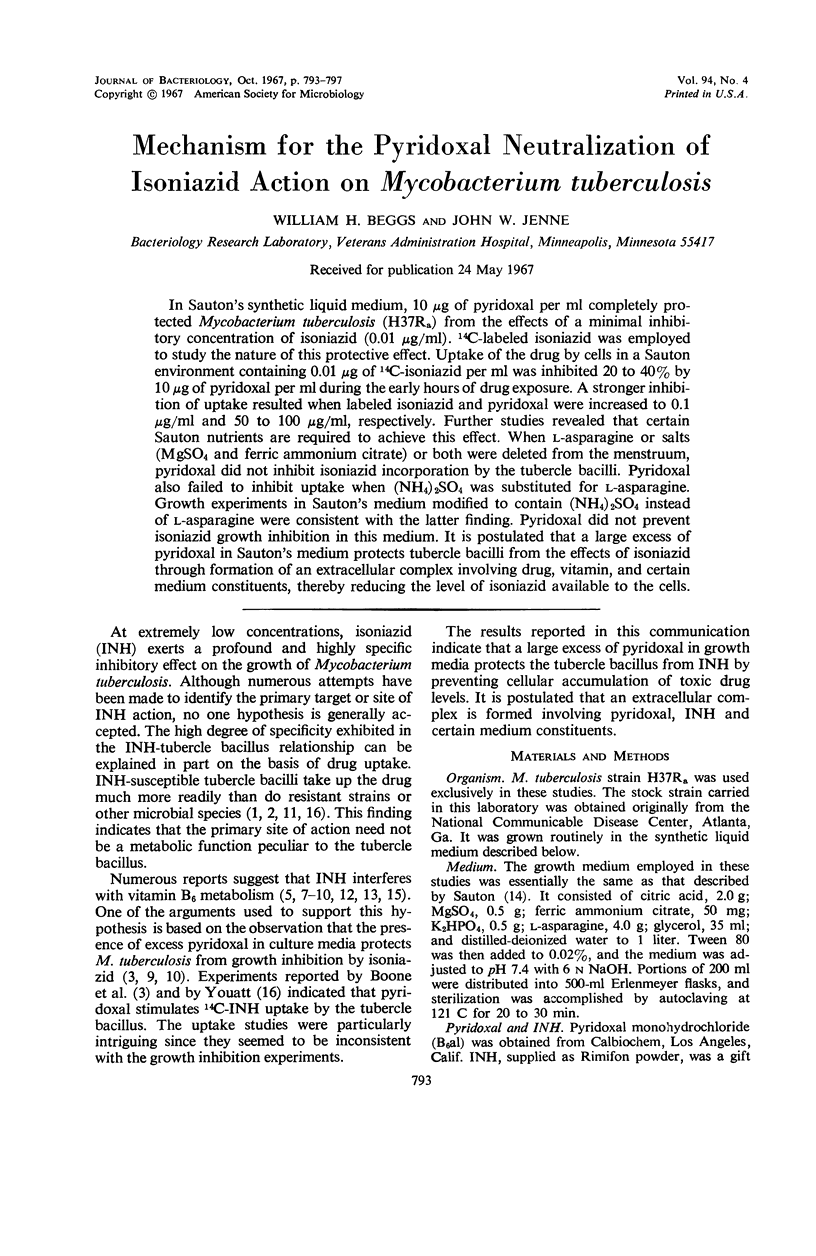
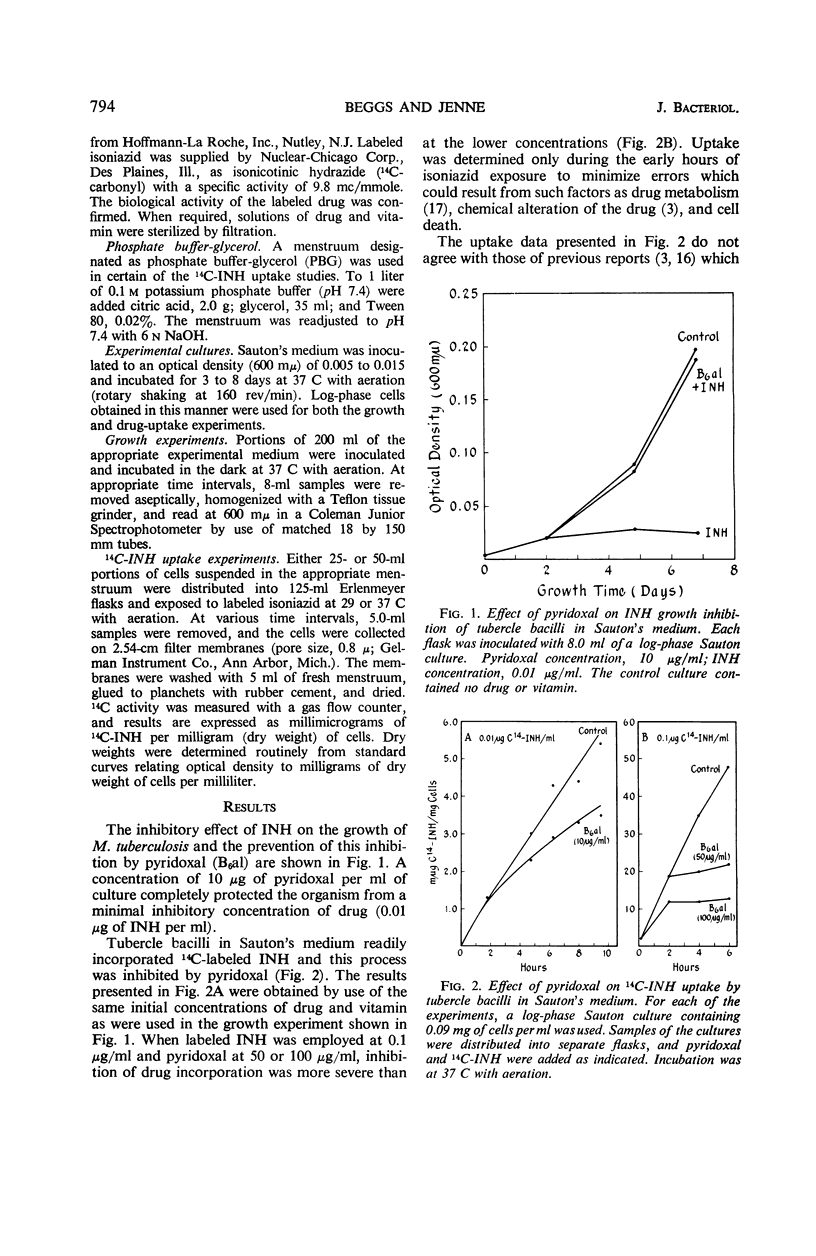
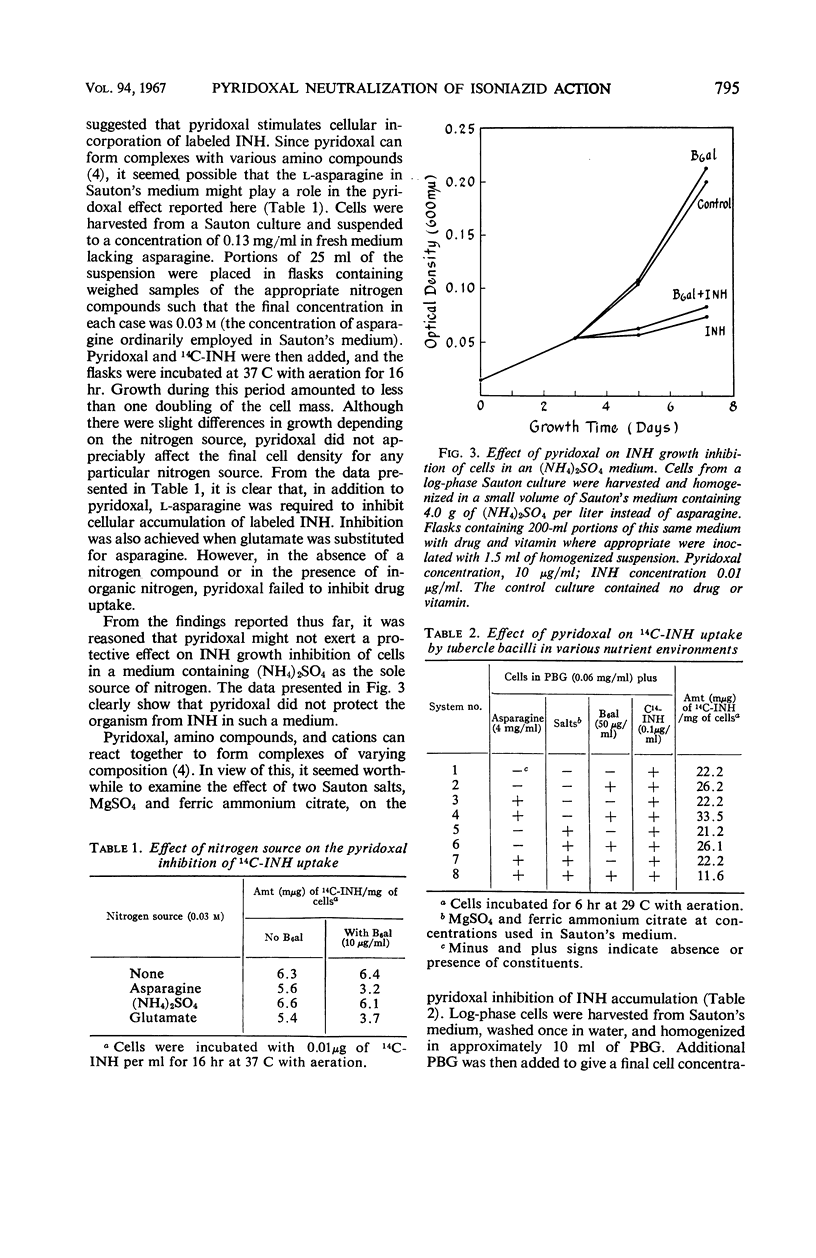
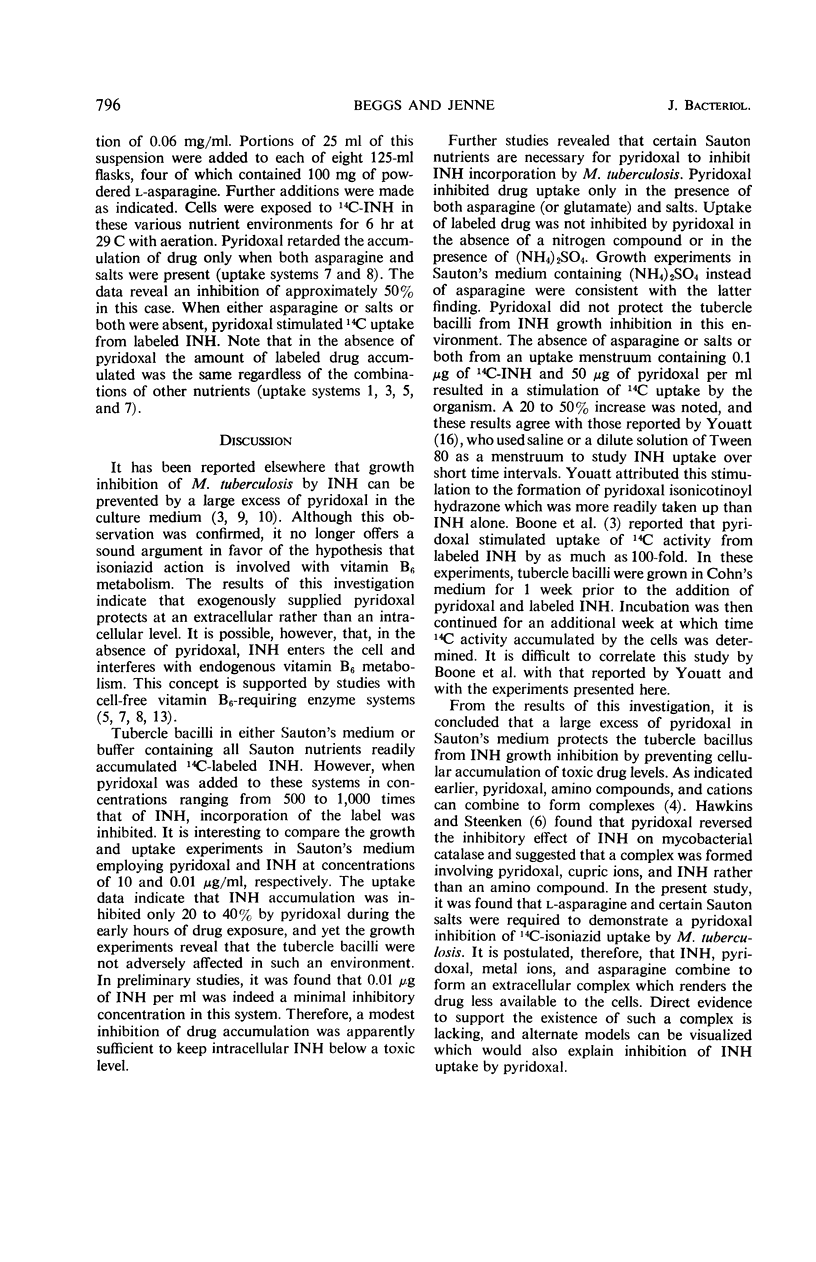
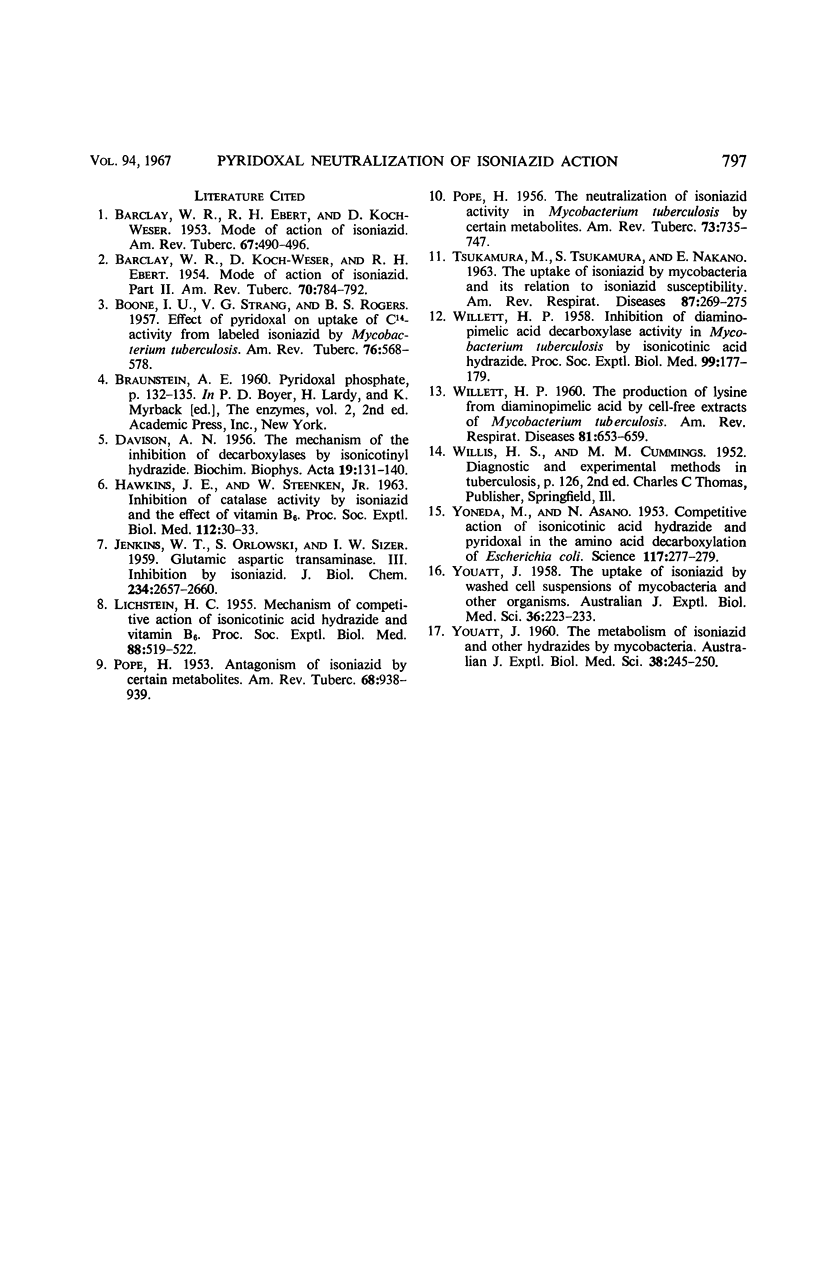
Selected References
These references are in PubMed. This may not be the complete list of references from this article.
- BARCLAY W. R., EBERT R. H., KOCHWESER D. Mode of action of isoniazid. Am Rev Tuberc. 1953 Apr;67(4):490–496. doi: 10.1164/art.1953.67.4.490. [DOI] [PubMed] [Google Scholar]
- BARCLAY W. R., KOCH-WESER D., EBERT R. H. Mode of action of isoniazid. II. Am Rev Tuberc. 1954 Nov;70(5):784–792. doi: 10.1164/art.1954.70.5.784. [DOI] [PubMed] [Google Scholar]
- BOONE I. U., STRANG V. G., ROGERS B. S. Effect of pyridoxal on uptake of C14-activity from labeled isoniazid by Mycobacterium tuberculosis. Am Rev Tuberc. 1957 Oct;76(4):568–578. doi: 10.1164/artpd.1957.76.4.568. [DOI] [PubMed] [Google Scholar]
- DAVIDSON A. N. The mechanism of the inhibition of decarboxylase by isonicotinyl hydrazide. Biochim Biophys Acta. 1956 Jan;19(1):131–140. doi: 10.1016/0006-3002(56)90394-8. [DOI] [PubMed] [Google Scholar]
- HAWKINS J. E., STEENKEN W., Jr Inhibition of catalase activity by isoniazid and the effect of vitamin B6. Proc Soc Exp Biol Med. 1963 Jan;112:30–33. doi: 10.3181/00379727-112-27941. [DOI] [PubMed] [Google Scholar]
- JENKINS W. T., ORLOWSKI S., SIZER I. W. Glutamic aspartic transaminase. III. Inhibition by isoniazid. J Biol Chem. 1959 Oct;234:2657–2660. [PubMed] [Google Scholar]
- LICHSTEIN H. C. Mechanism of competitive action of isonicotinic acid hydrazide and vitamin B6. Proc Soc Exp Biol Med. 1955 Apr;88(4):519–522. doi: 10.3181/00379727-88-21638. [DOI] [PubMed] [Google Scholar]
- POPE H. Antagonism of isoniazid by certain metabolites. Am Rev Tuberc. 1953 Dec;68(6):938–939. doi: 10.1164/art.1953.68.6.938. [DOI] [PubMed] [Google Scholar]
- POPE H. The neutralization of isoniazid activity in Mycobacterium tuberculosis by certain metabolites. Am Rev Tuberc. 1956 May;73(5):735–747. doi: 10.1164/artpd.1956.73.5.735. [DOI] [PubMed] [Google Scholar]
- TSUKAMURA M., TSUKAMURA S., NAKANO E. The uptake of isoniazid by mycobacteria and its relation to isoniazid susceptibility. Am Rev Respir Dis. 1963 Feb;87:269–275. doi: 10.1164/arrd.1963.87.2.269. [DOI] [PubMed] [Google Scholar]
- WILLETT H. P. Inhibition of diaminopimelic acid decarboxylase activity in Mycobacterium tuberculosis by isonicotinic acid hydrazide. Proc Soc Exp Biol Med. 1958 Oct;99(1):177–179. doi: 10.3181/00379727-99-24286. [DOI] [PubMed] [Google Scholar]
- WILLETT H. P. The production of lysine from diaminopimelic acid by cell-free extracts of Mycobacterium tuberculosis. Am Rev Respir Dis. 1960 May;81:653–659. doi: 10.1164/arrd.1960.81.5.653. [DOI] [PubMed] [Google Scholar]
- YONEDA M., ASANO N. Competitive action of isonicotinic acid hydrazide and pyridoxal in the amino acid decarboxylation of Escherichia coli. Science. 1953 Mar 13;117(3037):277–279. doi: 10.1126/science.117.3037.277. [DOI] [PubMed] [Google Scholar]
- YOUATT J. The metabolism of isoniazid and other hydrazides by mycobacteria. Aust J Exp Biol Med Sci. 1960 Jun;38:245–250. doi: 10.1038/icb.1960.25. [DOI] [PubMed] [Google Scholar]
- YOUATT J. The uptake of isoniazid by washed cell suspensions of Mycobacteria and other organisms. Aust J Exp Biol Med Sci. 1958 Jun;36(3):223–233. doi: 10.1038/icb.1958.24. [DOI] [PubMed] [Google Scholar]


